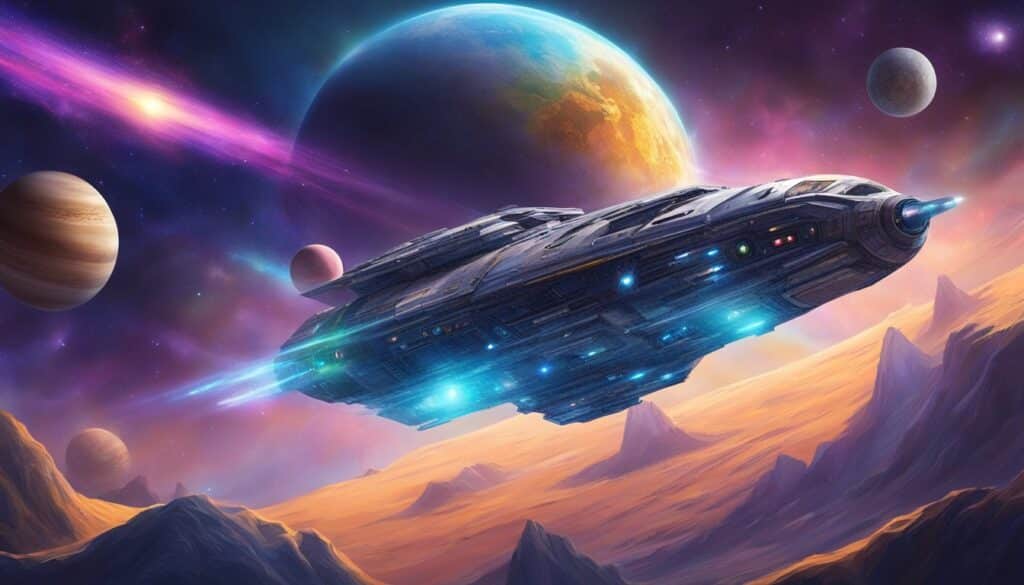Humanity has always been captivated by the mysteries of the cosmos, envisioning the vast expanse of space as the final frontier ripe for exploration. The allure of interstellar travel sings to our innate desire to discover and connect, leading us to ponder what it would be like to set foot on a planet orbiting a distant star. As technological advancements propel us closer to turning science fiction into science fact, the thoughts of meeting alien civilizations occupy the curious minds of scientists and dreamers alike.
Table of Contents
Toggle
The study of interstellar voyages isn’t just a flight of fancy but an evolving field grounded in physics and astronomy. Contemporary science enables us to map potential paths to the stars while speculating responsibly about the beings we might encounter. Such speculations are based on a mix of scientific principles, theories about the universe’s habitability, and an understanding of life’s potential diversity. As you immerse yourself in the narrative of interstellar dreams, consider the progress made and the monumental tasks lying ahead in this age-old quest.
Key Takeaways
- Interstellar travel is tightly interwoven with humanity’s yearning to explore and connect with the universe.
- Methodical scientific advancement steers the possibility of interstellar journeys from imagination towards reality.
- Encounters with extraterrestrial civilizations remain a speculative yet captivating aspect of our interstellar ambitions.
The Science of Interstellar Travel

The journey to other stars rests on advanced propulsion and a deep understanding of physics. You’re entering a realm where speed, distance, and time intertwine uniquely.
Propulsion Methods for Interstellar Journeys
Chemical Rockets: While you’re familiar with these from past space missions, they lack the efficiency for interstellar travel. Their impulse is simply not potent enough to propel us to neighboring star systems within a human lifetime.
Nuclear Propulsion: Envision a spacecraft with a reactor that heats a propellant or initiates a controlled nuclear reaction for thrust. You’d witness an increase in efficiency and a decrease in travel time to some degree.
Ion Drives: These operate by ionizing a propellant and accelerating it electromagnetically. They promise to be more fuel-efficient and are suitable for longer missions, albeit currently delivering very low thrust.
Light Sails: Imagine a thin, reflective sail pushed by light pressure or directed energy beams. This method relies on the momentum transfer from photons and can, in theory, achieve much greater speeds without traditional fuel.
Breakthrough Concepts: Scientists consider antimatter engines or warp drives that manipulate spacetime. Such technologies may offer a more practical route to the stars, although they remain theoretical at this point.
Challenges of Long-Distance Space Travel
Vast Distances: The neighboring star systems are several light-years away. Your current propulsion technology makes these distances seem insurmountable.
Surviving the Voyage: You’d need self-sustaining life support systems for the incredibly long journey. Radiation shielding, sustenance, waste recycling—the list of challenges goes on.
Communication Delays: As you venture further from Earth, delays in communication will grow, leading to near-autonomous operations or significant waiting periods for mission control guidance.
Interstellar Medium: Travel through space is not a void but a path laden with dust, gas, and cosmic rays that can damage spacecraft or alter trajectories.
Time Dilation and Relativity Effects
Relativity: As you approach significant fractions of light speed, time dilation becomes a factor to consider. For those on board, time would pass slower relative to those on Earth, according to Einstein’s theory of relativity.
Mission Duration: Considering relativistic effects, the experience of time would vary dramatically between the traveler and the observer, complicating mission planning and the synchronization of clocks.
Historical and Future Missions

In the quest for interstellar travel, humanity has launched missions that extend the reach of our scientific inquiry deep into the cosmos. You’ll find that past strategies and future plans reflect our yearning to explore beyond our solar system.
Voyager Probes and Beyond
The Voyager missions of the 1970s, namely Voyager 1 and Voyager 2, are monumental achivements. These robotic explorers are your messengers to the stars, housing golden records with sounds and images of Earth. Voyager 1 entered interstellar space in August 2012.
| Voyager Feature | Description |
|---|---|
| Launch Dates | Voyager 1: September 5, 1977 Voyager 2: August 20, 1977 |
| Key Milestones | First spacecraft to provide detailed images of Jupiter, Saturn, Uranus, and Neptune |
| Current Status | Voyager 1 and 2 are both in the interstellar medium, transmitting invaluable data back to Earth. |
Conceptual Designs for Future Spacecraft
Forward-thinking initiatives are shaping the blueprint of spacecrafts intended for interstellar travel. For example, Project Longshot and Breakthrough Starshot are concepts you should know about. Project Longshot is an unmanned probe designed to reach Alpha Centauri, using nuclear fusion to propel itself. This is a collaborative study between NASA and the US Naval Academy. On the other hand, Breakthrough Starshot intends to send ultra-light unmanned space probes at a significant fraction of the speed of light to Alpha Centauri, using light sail technology.
International Efforts and Collaboration
Your desire to connect with extraterrestrial worlds is a global one. International collaborations have led to the development of programs like the European Space Agency‘s Gaia spacecraft, which is mapping a billion stars in our galaxy. This effort is significant in plotting potential routes and destinations for future missions.
| International Missions | Purpose |
|---|---|
| Gaia (ESA) | Space observatory aiming to chart a three-dimensional map of the Milky Way |
| ExoMars (ESA and Roscosmos) | Mars mission to search for signs of past life and to test technologies for future manned missions |
Though traveling to an alien civilization remains a dream for now, each mission brings you a step closer to understanding your place in the universe and perhaps one day making contact.
Imagining Alien Civilizations

When you ponder the vastness of the universe, the possibility of alien civilizations existing is not just a fanciful idea but one that rests on scientific inquiry and the principles of probability.
Search for Extraterrestrial Intelligence (SETI)
The SETI initiative employs sophisticated radio telescopes to listen for signals that could originate from intelligent extraterrestrial sources. Your role as an observer is passive yet potent; you await the faint whisper of intelligence amid the cosmic noise. While detections like the famous “Wow! signal” remain unattributed to extraterrestrial sources, they emphasize the importance of analyzing anomalies with technological precision.
The Drake Equation and Estimating Probabilities
The Drake Equation offers a framework to estimate the number of active, communicative extraterrestrial civilizations in our galaxy. Here’s a simplified form:
N = R × fp × ne × fl × fi × fc × L*,
where:
- N is the number of civilizations with which we might communicate
- R* represents the average rate of star formation
- fp is the fraction of those stars that have planets
- ne is the average number of planets that could support life per star with planets
- fl is the fraction of planets that could support life, that actually develop life at some point
- fi is the fraction of planets with life that develop intelligent life
- fc is the fraction of civilizations that develop a technology that releases detectable signs of their existence
- L is the length of time these civilizations release detectable signals
As you input various scientific estimates into this equation, you quickly realize the probabilities range widely, highlighting the inherent uncertainties in this quest.
Potential Communication and Cultural Exchange
Should we ever establish communication with an alien civilization, the exchange of knowledge and culture becomes a crucial aspect to consider. Protocols for interstellar dialogue focus on simple, universal concepts – typically mathematics and physics as a common starting point. The Arecibo message, sent in 1974, serves as an historic benchmark using binary code to communicate fundamental aspects of humanity and biology. The nuances of cultural exchange, however, involve complexities beyond language, including transmission of abstract concepts such as beliefs, societal structures, and art, which might be vastly different from any Earth-centric analogs.
Frequently Asked Questions

Exploring the vastness of space comes with numerous questions. Here’s what you might be pondering about the journey beyond our solar system and the potential meeting with extraterrestrial beings.
What technological advances are needed for interstellar travel to become feasible?
Your journey to another star system will require propulsion systems far beyond our current capabilities. Research in nuclear fusion, antimatter, and laser sails is crucial to enable the high speeds necessary for crossing interstellar distances within a human lifetime.
What might first contact with an extraterrestrial civilization be like?
The first encounter with an alien civilization will likely be governed by strict protocols to avoid contamination and conflict. Communication will pose a significant challenge, and the initial exchange would be cautious, focused on establishing a common ground for understanding.
Could interstellar travel become a reality by 2100?
With the current pace of technological growth, it’s not unrealistic to think interstellar travel could be feasible by 2100. Advances in computing, materials science, and propulsion technology are needed to turn this dream into a reality. However, it is a monumental task that requires global collaboration and sustained investment.
What are the current limitations hindering the development of interstellar travel?
The distances between stars are vast, making the development of propulsion technology that can travel at a significant fraction of the speed of light a primary limitation. Additionally, cosmic radiation, vast energy requirements, and human life support for potentially centuries-long voyages are significant barriers.
What would be the energy requirements for a spacecraft to achieve interstellar travel?
To propel a spacecraft to the nearest stars within a human lifetime would require energy equivalent to multiple times the annual global energy consumption. Concepts like the Bussard ramjet are being considered, which would collect interstellar hydrogen for fusion as it travels, possibly reducing onboard fuel needs.
How are scientists planning to overcome the challenges of long-duration space travel?
Scientists are investigating closed-loop life support systems, hibernation or cryopreservation techniques, and artificial gravity to address the health and psychological challenges of long-duration voyages. Advances in artificial intelligence and robotics also promise to play a role in managing spacecraft systems autonomously.






